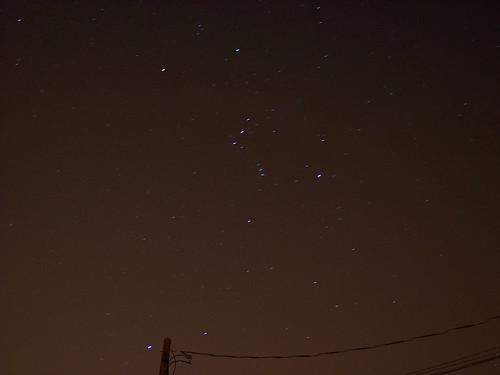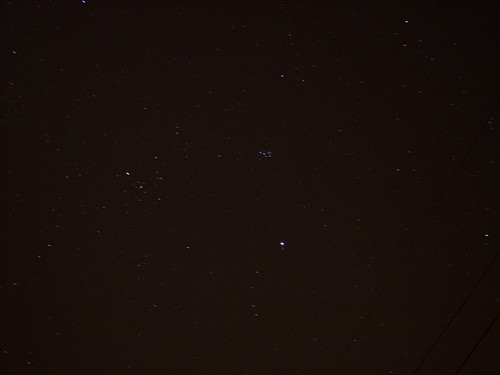
Orion, the great hunter, high in the southern sky. Before I went inside to get my camera, I even saw a meteor go across the entire width of Orion's shoulders. For a meteor to go acoss the entire width of the constellation, it was about the size of a grain of sand. Nothing more.
The bright star just to the left of the tip of the utility pole is Sirius, in the constellation Canis Major. Sirius, or α CMa (alpha Canis Major), is the second brightest star in the sky, second only to our own sun.
We are now in the Dog Days of summer, so called because it's so hot only dogs are crazy enough to be outside in the sun. It is also when Sirius is visible at night, so it became the Dog Star, a celestial indicator of the weather.

Then I looked up even higher and saw the Pleiades, not a constellation but an open cluster of stars, with 6 stars visible by my naked eye, which is amazing, for an urban area. The Pleiades in this photo are the small dipper-shaped cluster of blue-white stars just above the center of this photo. The bright "star" below the Pleiades (the brightest point in this photo) isn't a star at all, but Mars. Just below it, is a small vertical streak with a bright point on one end. That is a meteor I caught on film, the bright spot at the end of the line when the meteor finally completely burned up. With it being so small, it was nothing more than a dust speck, dying a glorious death in the atmosphere. I never would have been able to see it with the naked eye, it's too small.
Now, due to the rotation of the Earth, the stars all appear to be streaks, all moving in the same direction. If my exposure time was longer, you would be able to see long arcs, and if I point my camera at the North Star, which doesn't move, all other stars appear to rotate around it. So, in these two photos, the stars all appear to be streaks, more or less horizontal.
You can click on each photo to be taken to the Flickr page for each. If you have an account, you can scroll down a little, and click on "different sizes" on the right side, to see the full resolution image of each, or any other of my photos on Flickr.
For these two, here are the links for the full resolution pics:
The Pleiades, Mars, and a meteor
Orion and Sirius
4 comments:
Interesting that the length of the meteor trail should come down to its size, never having thought about it before. But I suppose it must do. Is there a strict relationship or is it purturbed by things like composition and angle of entry?
I'm not entirely sure. I would think that angle of entry would also have something to do with trail size, but brightness would be a clue to the size of the meteor. The brighter the trail, the larger the particle. I'm not sure about all the details with composition, etc, since I'm not a professional astronomer, nor have made meteors my area of focus. Nebulae and Galaxies are what I've focused on lately.
See the V to the left of the plieades? That's the face of Taurus. The V points down to another star which is the chest of the bull and there are feet further down. The horns are up from the V and you can see a couple of them in the picture. Very spiff shot.
I forgot about Taurus itself entirely, I was so focused on the Pleiades. I know that the Pleiades are in that constellation, but I was locked in by number of individual stars I could see.
Post a Comment